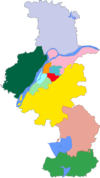Nanjing University of Posts and Telecommunications
This article includes a list of general references, but it remains largely unverified because it lacks sufficient corresponding inline citations. (February 2015) |
南京邮电大学 | |
 | |
Former names | Nanjing Institute of Posts and Telecommunications |
|---|---|
| Motto | 厚德 弘毅 求是 笃行 |
| Type | Public |
| Established | 1942 |
| President | Ye Meilan |
Academic staff | 2280 (Fall 2014) |
| Students | about 30000 (Fall 2014) |
| Undergraduates | 19454 (Fall 2014) |
| Postgraduates | 2281 |
| Location | , , |
| Campus | Xianlin, Sanpailou, Suojincun and Jiangning |
| Website | www |
| University rankings | |
|---|---|
| National – Overall | |
| BCUR National[1] | 91 (2018) |
Nanjing University of Posts and Telecommunications (also referred to NUPT or NJUPT; Chinese: 南京邮电大学; pinyin: Nánjīng Yóudiàn Dàxué) is a public university in Nanjing, Jiangsu province, China. It is a Chinese Ministry of Education Double First Class Discipline University, with Double First Class status in certain disciplines.[2]
History[]
Nanjing University of Posts predecessor was founded in 1942 in Shandong coastal anti-Japanese democratic base areas " postal Administration wartime cadres training " in July 1945 for the expansion of training courses "Post War" school, thereafter, once known as the Post and Telecommunications Department of Shandong University College And Shandong Post College . The school site has been in Lunan , Linyi , Wulian and other places. From 1942 to 1947, the head of the training class and the principal of the ensuing school were both concurrently served by Zhao Zhigang, then director of the General Post Office . In 1948, the school was named East China Post and Telecommunications School in Yidu ( Qingzhou ) and was affiliated with the East China Post and Telecommunications Administration . August 1949, the school from Shandong Jinan moved to Nanjing City.
In December 1950, the school was expanded to become the Nanjing Post and Telecommunications School directly under the Ministry of Posts and Telecommunications, which also held secondary professional and higher professional classes . In school between November 1951 to April 1953, the Ministry of Posts and decide once under the aegis of the East China Post and Telecommunications Authority leadership authority over and renamed the East China School of Posts and Telecommunications. In 1954, the school was divided into the Nanjing Telecom School and the Nanjing Post School of the Ministry of Posts and Telecommunications until July 1958. During the ten years from 1948 to 1958, the main leaders of the school were Sheng Tong, Geng Guoxing, Cao Danhui , Liu Yantian, Li Xuefeng, Shen Yili, Yu Jiang, and Liu Weiyi.
In August 1958, approved by the state , the Ministry of Posts and Telecommunications notified (58) Qianxiaozi No. 60:
"I hereby decide to change the Nanjing Telecommunications School into a higher school from August this year and designate it as the Nanjing University of Posts and Telecommunications. Undergraduate courses will include three majors: Radio Communication and Broadcasting, Telegraph and Telephone Communication, and Post and Telecommunications Organization and Planning. Bantong, the final capacity is set to 4000 people. For the purpose of tapping potential and saving investment, Nanjing Post School is merged into Nanjing Post and Telecommunications Institute. "
In September, the radio communications and telegraph telephone communication two five-year professional undergraduate 194 telecommunications and college students 48 admission. From May 1972 to February 1973, it was once renamed Nanjing Institute of Telecommunication Engineering . Since the establishment of the institute, the main leaders of the institute are: Qin Huali, Qin Jianqiu, Guo Xiangyun, Wang Hongbin, Zheng Weiwei.
Nanjing University of Posts and Telecommunications is a key institution affiliated to the Ministry of Posts and Telecommunications (the Ministry of Information Industry after March 1999). Since the reform of the national university leadership system in February 2000, Nanyou has implemented joint construction by the central and local governments, with Jiangsu Province as the mainstay.
In April 2005, after being studied by the Jiangsu Provincial People's Government and reported to the Ministry of Education for approval, Nanjing University of Posts and Telecommunications was renamed Nanjing University of Posts and Telecommunications.
In March 2009, after being studied by the Jiangsu Provincial People's Government and reported to the Ministry of Education for approval, Wujiang Vocational and Technical College of Nanjing University of Posts and Telecommunications was separated from Nanjing University of Posts and Telecommunications and became Suzhou Information Vocational and Technical College independently .
In March 2013, Nanjing University of Posts and Telecommunications merged with Nanjing Institute of Population Management Cadres .
Schools and departments[]
NUPT now has 14 colleges (departments) and 1 independent college. They are
- School of Telecommunication and Information Engineering
- School of Electronic, Optics Engineering&School of Microelectronics
- School of Computer Science & Software, School of information security
- School of Automation
- School of Materials Science & Engineering
- School of Natural Sciences
- School of Geography and Biological Information
- School of Media and Arts
- School of Economics and Management
- School of Humanities and Social Science
- School of Foreign Languages
- School of Oversea Education
- Department of Physical Education
- School of Continuing Education (School of Applied Technology)[3]
- College of Tongda
References[]
- ^ Best Chinese Universities Ranking, Overall Ranking - 2018
- ^ "教育部 财政部 国家发展改革委 关于公布世界一流大学和一流学科建设高校及建设 学科名单的通知 (Notice from the Ministry of Education and other national governmental departments announcing the list of double first class universities and disciplines)".
- ^ http://www.njupt.edu.cn/s/2/t/2/p/1/c/42/list.htm
Sources[]
- 南京邮电大学 (in Chinese). 南京邮电大学.
- "Nanjing University of Posts and Telecommunications". Nanjing University of Posts and Telecommunications.
- "Candidate to the Post of Deputy Secretary-General Houlin ZHAO, China". ITU.
Coordinates: 32°04′50″N 118°45′54″E / 32.0805°N 118.7650°E
- Nanjing University of Posts and Telecommunications
- Universities and colleges in Nanjing
- Telecommunication education

